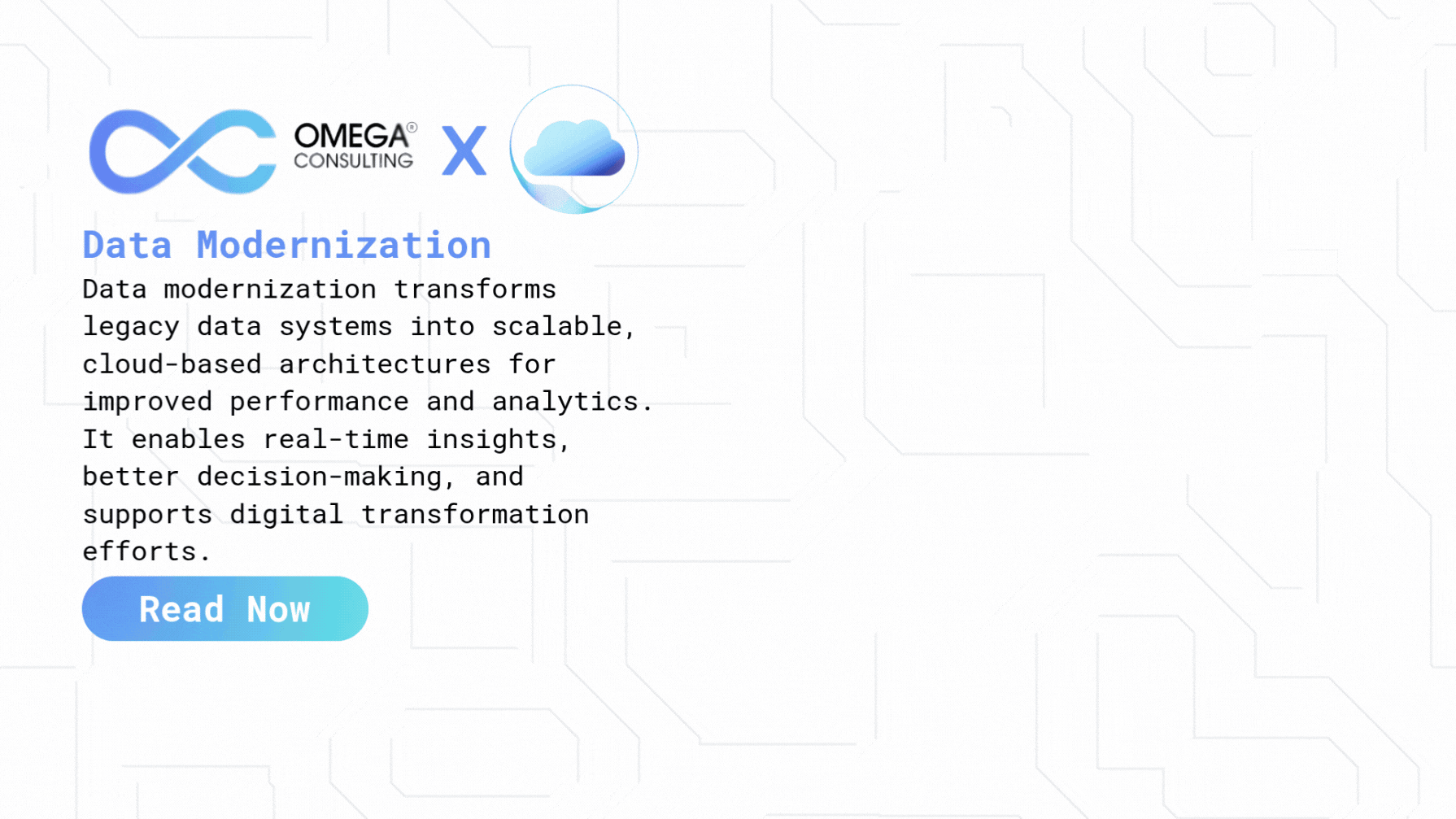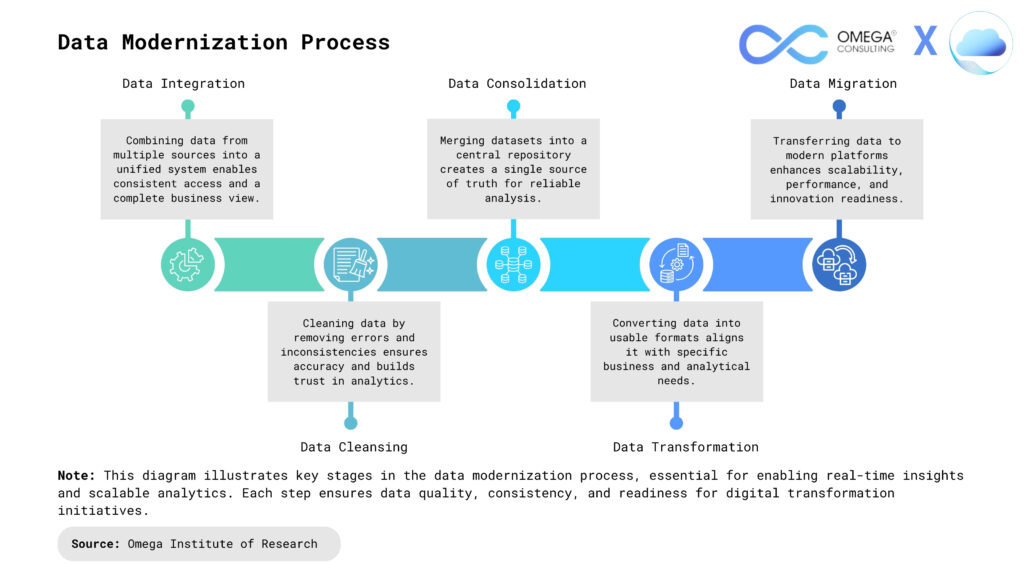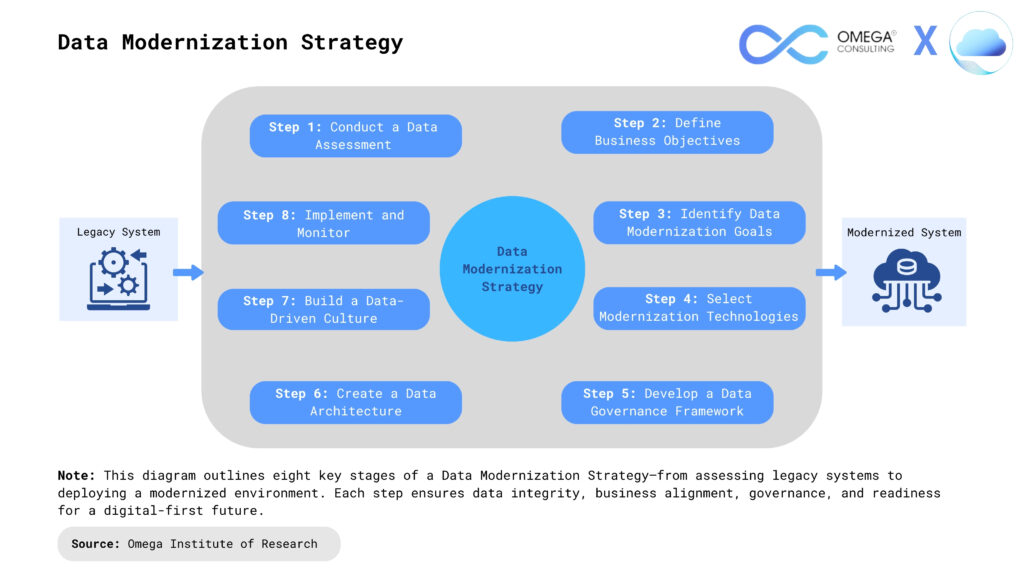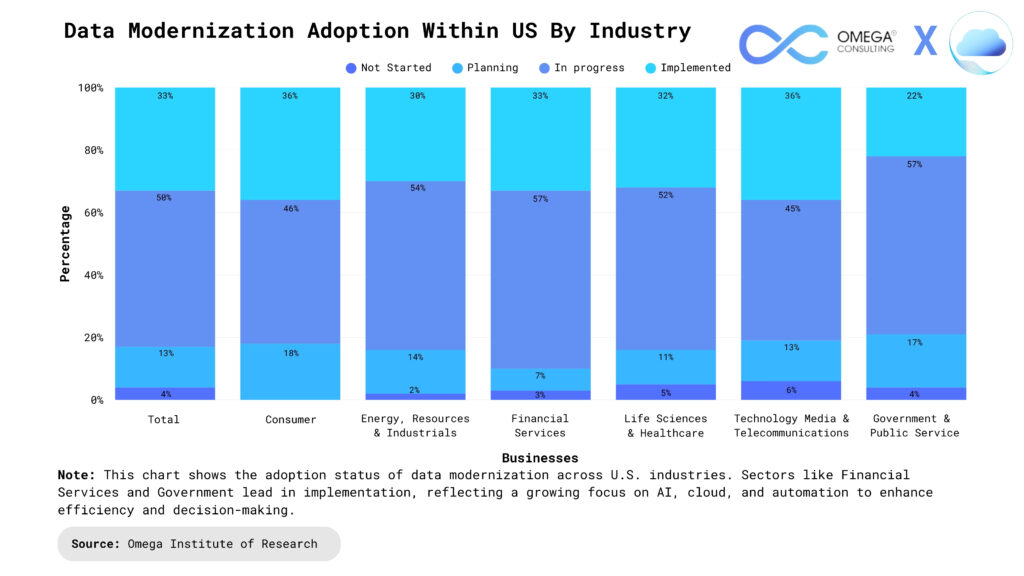- Industries
Industries
- Functions
Functions
- Insights
Insights
- Careers
Careers
- About Us
- Technology
- By Omega Team

In today’s data-driven landscape data dwells everywhere and data modernization is a crucial step for businesses to stay competitive. It enables enterprises to derive value from accumulated data and ensure informed decision-making. Moreover, it helps businesses rapidly identify opportunities and unlock their full potential by leveraging machine learning, analytics, and artificial intelligence techniques. Data modernization enables organizations to transform legacy systems into agile, cloud-based platforms that support real-time insights and innovation. By updating data systems, tools, and processes, businesses can improve decision-making, enhance data accessibility, and scale efficiently, ensuring they remain at the forefront of the data-driven age.

What Is Data Modernization?
Data modernization is the process of transforming legacy systems into modern, cloud-native platforms. It enables real-time analytics, scalability, and data-driven decisions by centralizing and optimizing enterprise data assets. The goal of data modernization is to ensure that businesses can not only store and manage data more efficiently but also derive valuable insights in real-time. By embracing cutting-edge technologies such as cloud computing, artificial intelligence (AI), machine learning (ML), and automation, organizations can achieve a more agile and dynamic data environment. This enables them to access and analyze data faster, drive innovation, and make better-informed decisions. Moreover, data modernization improves data security and accessibility contributing to overall efficiency in data quality management.

Key Components Of Data Modernization
Data integration: Data integration centralizes and consolidates data from various sources, ensuring seamless access and providing a unified view across the organization. By integrating data from disparate systems, businesses can improve operational efficiency and enhance the quality of insights derived from their data.
Data cleansing & quality: This improves data accuracy, completeness, and consistency by identifying and resolving errors or inconsistencies. This ensures that the data used for analysis is trustworthy, which in turn leads to reliable insights and more informed decision-making.
Data consolidation & warehousing: Data warehouse stores integrated data in a modern, scalable repository. It supports advanced analysis by providing a single, accessible location for all the organization’s data. A well-structured data warehouse enables faster data retrieval, making it easier for teams to access critical information on demand.
Data transformation: Data transformation changes data into a format suitable for analysis and reporting. It aligns data with the requirements of modern data systems and applications. Proper transformation enables practical analysis, integration with other data sources, and compatibility with advanced analytics tools.
Data migration: Data migration moves data from legacy systems to modern platforms. This is a critical step in the modernization process, as it ensures that valuable data is preserved and accessible in new systems.
Data governance & security: Data security ensures the protection of data through robust policies and controls, safeguarding against breaches and ensuring compliance with privacy regulations. This instills trust in the organization’s data management practices and mitigates risks related to data vulnerabilities.
Benefits Of Data Modernization
Enhanced decision-making: Access to real-time insights empowers teams to make predictive analytics and data-driven decisions. This allows businesses to act faster and more effectively, improving operational outcomes and aligning strategies with market needs.
Cost efficiency: Businesses can significantly lower maintenance costs by reducing their reliance on legacy systems. Modern infrastructures are more cost-effective to manage, freeing up resources for innovation and growth while improving financial and human capital allocation.
Improved data security and compliance: Modern systems offer enhanced security features, ensuring sensitive data is protected from breaches. Additionally, they help organizations comply with regulatory requirements, reducing legal risks and maintaining customer trust.
Scalability and flexibility: Modern data systems are designed to grow with the business. As data volumes and business needs evolve, these systems can easily scale to accommodate future demands, ensuring businesses remain adaptable and future-ready.
Increased innovation: With access to advanced analytics and big data tools, businesses can uncover insights that drive innovation, product development, and customer engagement. This enables companies to maintain a competitive edge in a rapidly changing market.
Stages of Data Modernization
Data Assessment: The first stage is data assessment, where businesses evaluate the current state of their data and systems. The assessment involves identifying all data sources, understanding data quality, and assessing existing infrastructure. Organizations review data storage, usage patterns, and current issues. The data assessment step helps determine what needs to be modernized and sets the foundation for the modernization process.
Pre-Migration: In the pre-migration stage, organizations prepare for the actual migration by planning and setting up the necessary processes. Planning includes selecting the right tools and technologies for the new system and designing a migration strategy. Businesses establish data governance policies, define roles and responsibilities, and create a detailed migration plan. Ensuring data quality and cleansing data before migration is critical in this phase.
Data Transformation: Data is converted into a format suitable for the new system during data transformation. Transformation involves cleaning the data to remove errors, converting data formats, and integrating data from different sources. The goal is to ensure data is consistent, accurate, and aligned with the new system’s requirements. This step includes mapping data from old formats to new ones and preparing it for migration.
Migration: The migration stage involves moving data from the old system to the new one according to the earlier migration plan. Organizations transfer data in batches or all at once depending on the strategy. Users also monitor the migration to ensure data is transferred accurately and without loss. This stage may include testing to confirm that the data in the new system matches the original data.
Post-Migration: After migration, the post-migration stage focuses on verifying and optimizing the new system. Organizations conduct thorough testing to ensure the data is correctly integrated and all functionalities work as expected. This stage also involves training users on the new system and addressing any issues. Finally, businesses monitor the new system for performance and adjust as needed to optimize efficiency and usability.

Best Practices For Data Modernization
Define clear objectives: Establish specific goals for data modernization, such as improving analytics capabilities, reducing operational costs, or enhancing customer experiences. Clear objectives guide the strategy and help prioritize initiatives.
Engage stakeholders early: Collaborate with stakeholders across departments to ensure alignment and buy-in. By engaging leaders and users early in the process, organizations can ensure the modernization strategy meets organizational goals and addresses key pain points.
Prioritize data quality: Data integrity is critical for a successful modernization process. Regular data cleansing and validation should be incorporated into the migration process to ensure high-quality data that can generate actionable insights.
Invest in scalable solutions: Select modern data tools and platforms that can evolve with your organization’s needs. Scalable solutions are essential, especially when dealing with big data and complex analytics workloads that will only grow over time.
Monitor progress continuously: Use metrics to evaluate the success of modernization efforts. Ongoing monitoring allows organizations to assess whether they are meeting objectives, identify areas for improvement, and adapt the strategy as needed to meet future challenges.

Data Modernization Use Cases
Healthcare: Data modernization in healthcare enables providers to consolidate patient data from electronic health records, IoT devices, and medical imaging to create a unified view of the patient, leading to more accurate diagnoses and personalized treatment. It supports predictive analytics to foresee health complications, reduces hospital readmissions, and automates administrative processes, thereby improving operational efficiency and patient outcomes.
Financial Services: In financial services, data modernization empowers institutions to detect fraud in real-time using AI-driven analytics, improve risk assessment through faster data processing, and ensure compliance with evolving regulations. Unified data platforms help provide personalized financial products, streamline operations, and enhance customer trust with accurate, secure data handling.
Government: Modernizing data infrastructure in government enhances service delivery by integrating disparate citizen data systems to offer more efficient, personalized public services. It increases transparency and accountability, supports data-driven policy-making, and improves crisis response capabilities by enabling real-time data access and analysis across departments.
Manufacturing: Manufacturers use data modernization to enable predictive maintenance by analyzing sensor data to anticipate equipment failures, thereby minimizing downtime. It optimizes supply chain operations with real-time insights, improves product quality through automated defect detection, and accelerates innovation by leveraging integrated design and production data.
Retail: Retailers leverage modern data systems to deliver personalized shopping experiences through customer behavior analysis, optimize inventory with real-time tracking, and increase sales through targeted marketing. Integration of online and offline data enhances omnichannel strategies, improves demand forecasting, and streamlines supply chain logistics.
Telecommunications: Telecom providers modernize their data platforms to predict customer churn, optimize network performance, and personalize service offerings. Real-time analytics enable faster issue resolution, targeted promotions based on usage patterns, and more agile product development in response to evolving customer needs and market demands.
Conclusion
The future of data modernization is driven by AI, automation, and real-time analytics, transforming how businesses store, process, and use data. As companies move from legacy systems to scalable, AI-powered architectures, modernization becomes a strategic imperative. Trends like real-time processing, AI-driven automation, and self-optimizing pipelines are redefining how insights are extracted and decisions made. Cloud-native platforms, machine learning, and modern governance are enabling faster decisions, stronger security, better cost efficiency, and seamless scalability. In a world of growing data complexity, continuous modernization is key to turning data into intelligence, innovation, and competitive advantage.
- https://www.ibm.com/think/topics/data-modernization
- https://quantiphi.com/blog/what-is-data-modernization/
- https://atlan.com/data-modernization/
- https://www.acceldata.io/article/what-is-data-modernization
- https://www.astera.com/type/blog/data-modernization/
- https://www.tredence.com/blog/data-modernization
Subscribe
Select topics and stay current with our latest insights
- Functions